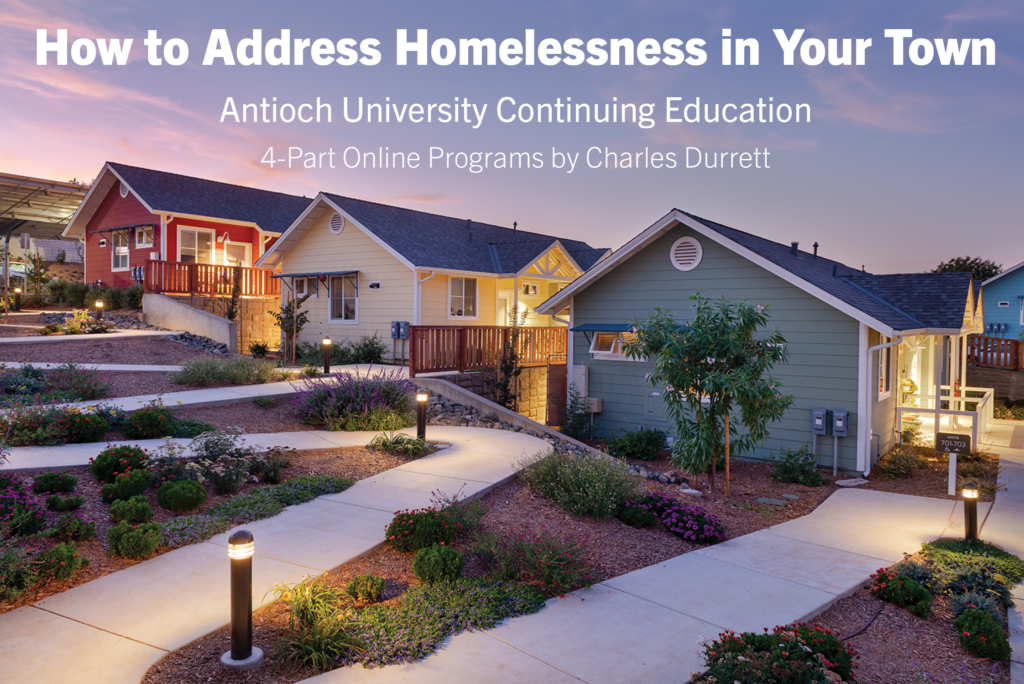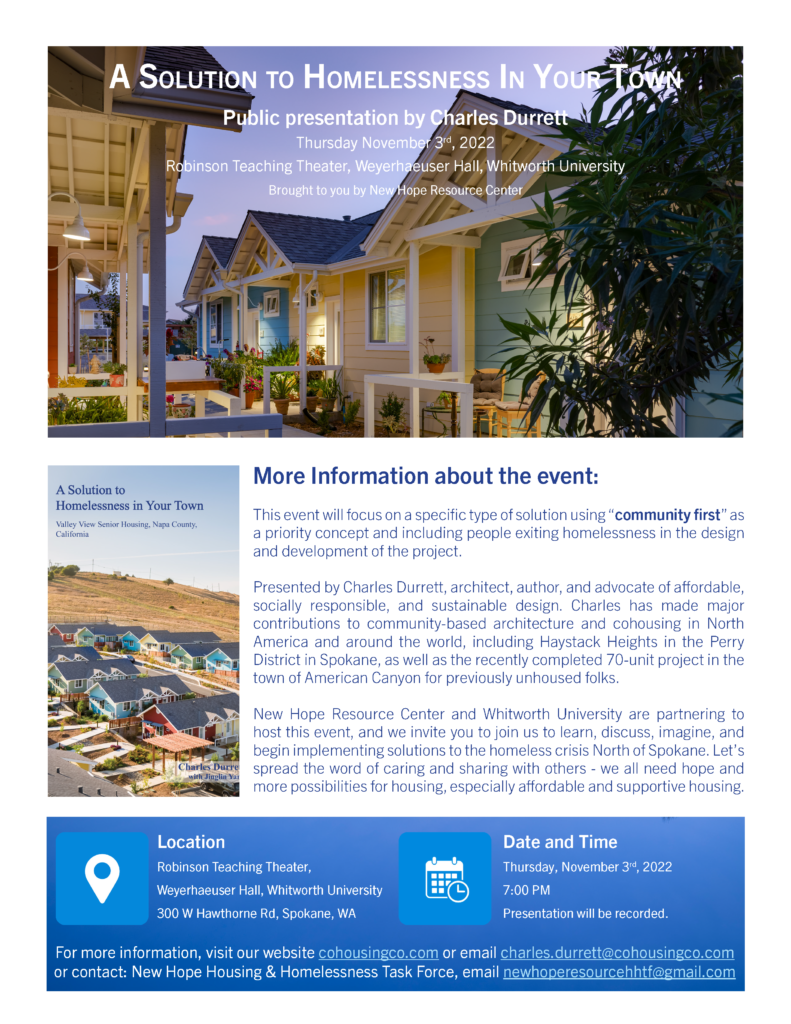Nov. 3rd. 2022
Please join Charles Durrett, architect, author, and advocate of affordable, socially responsible, and sustainable design for a presentation on the development of a new rural community in North Spokane Valley, Washington on Nov. 3rd, 2022 at 7 pm. The presentation will be recorded and the location is:
Robinson Teaching Theater
Weyerhaeuser Hall, Whitworth University
300 W. Hawthorne Rd.
Spokane, Wa,
Charles is the author of A Solution To Homeslessness In Your Town that can be purchased on Amazon
And Village Books
“How to eradicate homelessness? How about building homes, and making them efficient and economical? The time for housing as if people mattered is here, and so is a sensible plan.” Timothy Miller, Foreword to A Solution to Homelessness in Your Town
“The importance of giving the homeless chance to rebuild their lives by housing them can’t be underestimated. But helping them form communities where they feel safe and emotionally supported is even more helpful to their recovery.” Kate Nichols, Review of A Solution to Homelessness in Your Town
“One of the most surprising and inspiring aspects of Durrett’s story is how the obvious human need created by the ever-growing problem of homelessness forged a synergistic bond between city officials, architects, contractors, and future residents that motivated all involved to build a community that everyone could point to with pride saying, “We did this ourselves.” Carl Hall, Professor of Philosophy, Housing Activist
About Charles Durett
With partner, Kathryn McCamant, Durrett is credited with coining the English term “cohousing” and introducing the cohousing model to North America.[1] Cohousing is a type of intentional community composed of small private homes with full kitchens, supplemented by extensive common facilities. A cohousing community is planned, owned and managed by the residents, groups of people who want more interaction with their neighbours. In recent years he has focused on cohousing for older persons.
Durrett and McCamant designed Muir Commons, the first cohousing community in North America, and has designed or consulted on the design of over 50 cohousing communities in North America. He has also consulted on many other cohousing projects around the world.[2]
He is a major proponent of senior cohousing, also known as elder cohousing, which are residential communities specifically designed for seniors. There are at least three senior cohousing communities in the U.S., one each in California, Colorado, and Virginia. More are in planning, according to Durrett.[3][4] According to an American Association of Retired Persons representative, senior cohousing is “very interesting niche housing” that is needed as an option.[5]
Durrett is author of The Senior Cohousing Handbook: A Community Approach to Independent Living (2009, 2nd edition), and with Kathryn McCamant, is co-author of Cohousing: A Contemporary Approach to Housing Ourselves (1988) and Creating Cohousing: Building Sustainable Communities (2011).
He is recipient or co-recipient of numerous awards from the American Institute of Architects and others for various completed projects. This includes a United Nation’s World Habitat Award in 2001 for the East Lake Commons Conservation Community project in Atlanta, Georgia.[2][6] A more recent award was the Vision 2020 Award of the Sierra Business Council.[7]
Durrett has an architecture degree in 1982 from the College of Architecture and Environmental Design, of Cal Poly San Luis Obispo. Since 2009, he has been advocating for senior cohousing, beginning in August of that year, with a book signing tour in ten western U.S. cities.[8]
How to Address Homelessness in Your Town

An Antioch University Professional Development Certificate
With Charles Durrett, Architect Emeritus AIA
Four Week On-Line Course
In this 4-week course, you’ll learn from the leading architect and builder of cohousing communities globally. Durrett will impart his decades of experience so that you understand the dynamics of addressing homelessness in your community. This course is for legislators, municipal employees, architects, planners, designers, urban volunteers, and all good citizens.
4-part LIVE ONLINE Program / $250
Tuesdays Oct. 25 – Nov. 15, 2022
4:00 pm – 6:00 pm (Pacific Time) / 7:00 pm – 9:00 pm (Eastern Time)
Classes are limited to 30 students to allow for questions, collaboration, and successful learning.
The first 20 people who sign up for the class will get a copy of A Solution to Homelessness in Your Town for free.
The sessions will be recorded for access by those who register only. We hope you will be able to attend all four LIVE sessions but will provide full video and transcripts for those with unexpected conflict.
Course Description
The average homeless person in the U.S. dies at 49. That is a 30-year death sentence. When I have asked folks in Denmark, “Why do I not see any homeless people here?” The answer is usually “because that could be my brother.” When I ask people in the U.S. why there are so many, too many people say, “You know Chuck it’s Darwinian.” Those are directly opposite. But it’s also not wise, and not just. One out of 9 people who experience homelessness are veterans—people who served our country, then cast adrift. This project shows that we should and can do something. When Matt spoke at the grand opening for Valley View Senior Housing, he asked the 150 attendees rhetorically: “You know the freeway that you drove in on this morning.” He paused, held back his tears, and said “well, I lived under that overpass for the last 6 years,” paused again, “and I am a Vietnam Vet.” He then said, “When I saw my new home here, I thought that I had gone to heaven, and I said to myself, I will be staying here until I do actually go to heaven.”
State and local governments together spend $20,000-$40,000 each year on each homeless person (hospital stays, jail, police, fire department, and mental healthcare are the top 5 of the many costs). 480 people signed up for these 70 tiny cottages in Napa County on the first day. Every town can get behind this. “This project was accepted by all of the neighbors because of the process and the product” said Brent Cooper, head of Community Development in the town of American Canyon.

